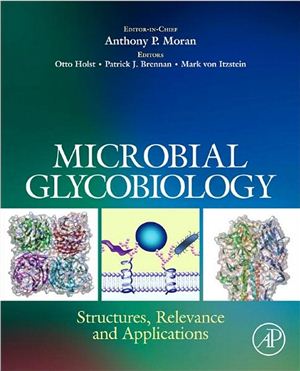AP. 2009. 982 p.
Microbial glycolipids, glycoproteins and glycopolymers
Bacterial cell envelope peptidoglycan
Core region and lipid A components of lipopolysaccharides
O-Specific polysaccharides of Gram-negative bacteria
Teichoic acids, lipoteichoic acids and related cell wall glycopolymers of Gram-positive bacteria
Bacterial capsular polysaccharides and exopolysaccharides
Bacterial surface layer glycoproteins and non-classical secondary cell wall polymers
Glycosylation of bacterial and archaeal flagellins
Glycosylated components of the mycobacterial cell wall: structure and function
Glycoconjugate structure and function in fungal cell walls
Cytoplasmic carbohydrate molecules: trehalose and glycogen
Glycosylated compounds of parasitic protozoa
Analytical approaches towards the structural characterization of microbial wall glycopolymers
Single-molecule characterization of microbial polysaccharides
Viral surface glycoproteins in carbohydrate recognition: structure and modelling
Biosynthesis of cell wall teichoic acid polymers
Synthesis of microbial glycosylated components
Biosynthesis and membrane assembly of lipid A
Biosynthesis and assembly of capsular polysaccharides
Biosynthesis of O-antigen chains and assembly
Biosynthesis of the mycobacterial cell envelope components
Biosynthesis of fungal and yeast glycans
Synthesis of microbial glycosylated components. B. Chemical Synthesis
Chemical synthesis of bacterial lipid A
Chemical synthesis of the core oligosaccharide of bacterial lipopolysaccharide
Chemical synthesis of lipoteichoic acid and derivatives
Chemical synthesis of parasitic glycoconjugates and phosphoglycans
Microbe-host glycosylated interactions
Bacterial lectin-like interactions in cell recognition and adhesion
Lectin-like interactions in virus–cell recognition: human immunodeficiency virus and C-type lectin interactions
Sialic acid-specific microbial lectins
Bacterial toxins and their carbohydrate receptors at the host–pathogen interface
Toll-like receptor recognition of lipoglycans, glycolipids and lipopeptides
NOD receptor recognition of peptidoglycan
Microbial interaction with mucus and mucins
Mannose–fucose recognition by DC-SIGN
Host surfactant proteins in microbial recognition
T-cell recognition of microbial lipoglycans and glycolipids
Bilogical relevance of microbial glycosylated components. A. Environmental relevance
Extracellular polymeric substances in microbial biofilms
Physicochemical properties of microbial glycopolymers
Microbial biofilm-related polysaccharides in biofouling and corrosion
Microbial glycosylated components in plant disease
Biological relevance of microbial glycosylated components. B. Medical relevance
Antigenic variation of microbial surface glycosylated molecules
Phase variation of bacterial surface glycosylated molecules in immune evasion
Molecular mimicry of host glycosylated structures by bacteria
Role of microbial glycosylation in host cell invasion
Biotechnological and medical applications
Exopolysaccharides produced by lactic acid bacteria in food and probiotic applications
Industrial exploitation by genetic engineering of bacterial glycosylation systems
Glycomimetics as inhibitors in anti-infection therapy
Bacterial polysaccharide vaccines: glycoconjugates and peptide-mimetics
Immunomodulation by zwitterionic polysaccharides
Future potential of glycomics in microbiology and infectious diseases
Microbial glycolipids, glycoproteins and glycopolymers
Bacterial cell envelope peptidoglycan
Core region and lipid A components of lipopolysaccharides
O-Specific polysaccharides of Gram-negative bacteria
Teichoic acids, lipoteichoic acids and related cell wall glycopolymers of Gram-positive bacteria
Bacterial capsular polysaccharides and exopolysaccharides
Bacterial surface layer glycoproteins and non-classical secondary cell wall polymers
Glycosylation of bacterial and archaeal flagellins
Glycosylated components of the mycobacterial cell wall: structure and function
Glycoconjugate structure and function in fungal cell walls
Cytoplasmic carbohydrate molecules: trehalose and glycogen
Glycosylated compounds of parasitic protozoa
Analytical approaches towards the structural characterization of microbial wall glycopolymers
Single-molecule characterization of microbial polysaccharides
Viral surface glycoproteins in carbohydrate recognition: structure and modelling
Biosynthesis of cell wall teichoic acid polymers
Synthesis of microbial glycosylated components
Biosynthesis and membrane assembly of lipid A
Biosynthesis and assembly of capsular polysaccharides
Biosynthesis of O-antigen chains and assembly
Biosynthesis of the mycobacterial cell envelope components
Biosynthesis of fungal and yeast glycans
Synthesis of microbial glycosylated components. B. Chemical Synthesis
Chemical synthesis of bacterial lipid A
Chemical synthesis of the core oligosaccharide of bacterial lipopolysaccharide
Chemical synthesis of lipoteichoic acid and derivatives
Chemical synthesis of parasitic glycoconjugates and phosphoglycans
Microbe-host glycosylated interactions
Bacterial lectin-like interactions in cell recognition and adhesion
Lectin-like interactions in virus–cell recognition: human immunodeficiency virus and C-type lectin interactions
Sialic acid-specific microbial lectins
Bacterial toxins and their carbohydrate receptors at the host–pathogen interface
Toll-like receptor recognition of lipoglycans, glycolipids and lipopeptides
NOD receptor recognition of peptidoglycan
Microbial interaction with mucus and mucins
Mannose–fucose recognition by DC-SIGN
Host surfactant proteins in microbial recognition
T-cell recognition of microbial lipoglycans and glycolipids
Bilogical relevance of microbial glycosylated components. A. Environmental relevance
Extracellular polymeric substances in microbial biofilms
Physicochemical properties of microbial glycopolymers
Microbial biofilm-related polysaccharides in biofouling and corrosion
Microbial glycosylated components in plant disease
Biological relevance of microbial glycosylated components. B. Medical relevance
Antigenic variation of microbial surface glycosylated molecules
Phase variation of bacterial surface glycosylated molecules in immune evasion
Molecular mimicry of host glycosylated structures by bacteria
Role of microbial glycosylation in host cell invasion
Biotechnological and medical applications
Exopolysaccharides produced by lactic acid bacteria in food and probiotic applications
Industrial exploitation by genetic engineering of bacterial glycosylation systems
Glycomimetics as inhibitors in anti-infection therapy
Bacterial polysaccharide vaccines: glycoconjugates and peptide-mimetics
Immunomodulation by zwitterionic polysaccharides
Future potential of glycomics in microbiology and infectious diseases

